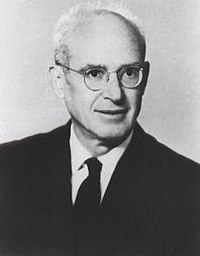Nathan Rosen
| Nathan Rosen | |
|---|---|

Nathan Rosen (1909-1995)
|
|
| Born | March 22, 1909 Brooklyn, New York, USA |
| Died | December 18, 1995 (age 86) Haifa, Israel |
| Residence | Israel |
| Citizenship | Israeli |
| Nationality | US-Israeli |
| Fields | Physicist |
| Institutions |
Institute for Advanced Study Technion Ben Gurion University |
| Alma mater | Massachusetts Institute of Technology |
| Doctoral advisor | John Clarke Slater |
| Other academic advisors | Albert Einstein |
| Doctoral students |
Moshe Carmeli Asher Peres |
| Known for |
EPR paradox Sticky bead argument Einstein–Rosen bridge |
Nathan Rosen (Hebrew: נתן רוזן; March 22, 1909 – December 18, 1995) was an American-Israeli physicist noted for his study on the structure of the hydrogen atom and his work with Albert Einstein and Boris Podolsky on entangled wave functions and the EPR paradox. The Einstein–Rosen bridge, later named the wormhole, was a theory of Nathan Rosen.
Nathan Rosen was born into a Jewish family in Brooklyn, New York. He attended MIT during the Great Depression, where he received a bachelor's degree in electromechanical engineering and later a master's and a doctorate in physics. As a student he published several papers of note, one being “The Neutron,” which attempted to explain the structure of the atomic nucleus a year before their discovery by James Chadwick. He also developed an interest in wave functions, and later, gravitation, when he worked as a fellow at the University of Michigan and Princeton University.
At the beginning of the 20th century science was progressing quickly and the inner workings of the atom were just beginning to be discovered. In 1900, Max Planck proposed the quantum theory, the idea that all energy moves in discrete amounts called quanta. In 1905, Albert Einstein published his theory of special relativity, which would be instrumental in the progression of physics and the understanding of the universe. Around 1927, Niels Bohr and Werner Heisenberg, collaborating with many other physicists, developed the Copenhagen interpretation of quantum theory, determining the probabilities of the movement of particles. These breakthroughs provided the model for the structure and workings of the atom and drove the revolution that would sweep up Nathan Rosen.
...
Wikipedia
